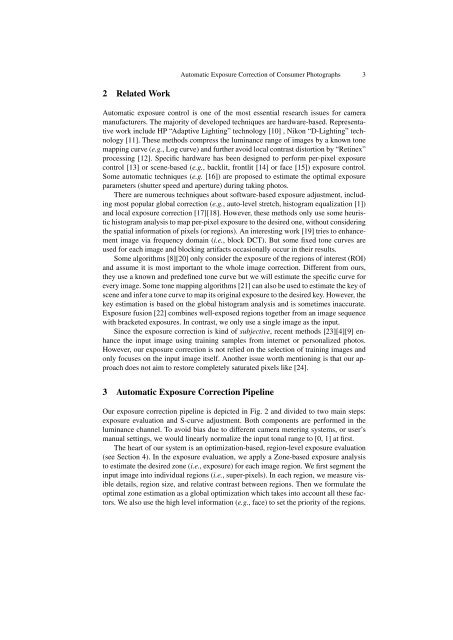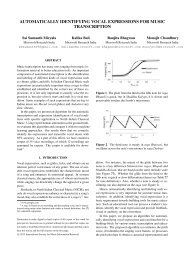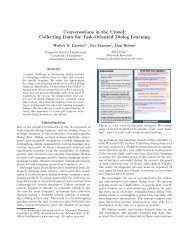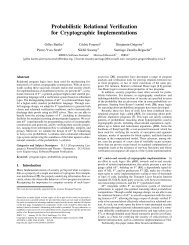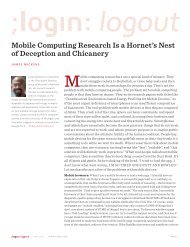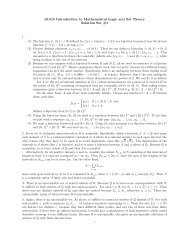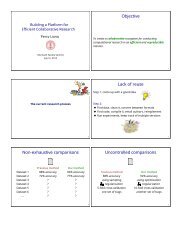Automatic Exposure Correction of Consumer Photographs
Automatic Exposure Correction of Consumer Photographs
Automatic Exposure Correction of Consumer Photographs
Create successful ePaper yourself
Turn your PDF publications into a flip-book with our unique Google optimized e-Paper software.
2 Related Work<br />
<strong>Automatic</strong> <strong>Exposure</strong> <strong>Correction</strong> <strong>of</strong> <strong>Consumer</strong> <strong>Photographs</strong> 3<br />
<strong>Automatic</strong> exposure control is one <strong>of</strong> the most essential research issues for camera<br />
manufacturers. The majority <strong>of</strong> developed techniques are hardware-based. Representative<br />
work include HP “Adaptive Lighting” technology [10] , Nikon “D-Lighting” technology<br />
[11]. These methods compress the luminance range <strong>of</strong> images by a known tone<br />
mapping curve (e.g., Log curve) and further avoid local contrast distortion by “Retinex”<br />
processing [12]. Specific hardware has been designed to perform per-pixel exposure<br />
control [13] or scene-based (e.g., backlit, frontlit [14] or face [15]) exposure control.<br />
Some automatic techniques (e.g. [16]) are proposed to estimate the optimal exposure<br />
parameters (shutter speed and aperture) during taking photos.<br />
There are numerous techniques about s<strong>of</strong>tware-based exposure adjustment, including<br />
most popular global correction (e.g., auto-level stretch, histogram equalization [1])<br />
and local exposure correction [17][18]. However, these methods only use some heuristic<br />
histogram analysis to map per-pixel exposure to the desired one, without considering<br />
the spatial information <strong>of</strong> pixels (or regions). An interesting work [19] tries to enhancement<br />
image via frequency domain (i.e., block DCT). But some fixed tone curves are<br />
used for each image and blocking artifacts occasionally occur in their results.<br />
Some algorithms [8][20] only consider the exposure <strong>of</strong> the regions <strong>of</strong> interest (ROI)<br />
and assume it is most important to the whole image correction. Different from ours,<br />
they use a known and predefined tone curve but we will estimate the specific curve for<br />
every image. Some tone mapping algorithms [21] can also be used to estimate the key <strong>of</strong><br />
scene and infer a tone curve to map its original exposure to the desired key. However, the<br />
key estimation is based on the global histogram analysis and is sometimes inaccurate.<br />
<strong>Exposure</strong> fusion [22] combines well-exposed regions together from an image sequence<br />
with bracketed exposures. In contrast, we only use a single image as the input.<br />
Since the exposure correction is kind <strong>of</strong> subjective, recent methods [23][4][9] enhance<br />
the input image using training samples from internet or personalized photos.<br />
However, our exposure correction is not relied on the selection <strong>of</strong> training images and<br />
only focuses on the input image itself. Another issue worth mentioning is that our approach<br />
does not aim to restore completely saturated pixels like [24].<br />
3 <strong>Automatic</strong> <strong>Exposure</strong> <strong>Correction</strong> Pipeline<br />
Our exposure correction pipeline is depicted in Fig. 2 and divided to two main steps:<br />
exposure evaluation and S-curve adjustment. Both components are performed in the<br />
luminance channel. To avoid bias due to different camera metering systems, or user’s<br />
manual settings, we would linearly normalize the input tonal range to [0, 1] at first.<br />
The heart <strong>of</strong> our system is an optimization-based, region-level exposure evaluation<br />
(see Section 4). In the exposure evaluation, we apply a Zone-based exposure analysis<br />
to estimate the desired zone (i.e., exposure) for each image region. We first segment the<br />
input image into individual regions (i.e., super-pixels). In each region, we measure visible<br />
details, region size, and relative contrast between regions. Then we formulate the<br />
optimal zone estimation as a global optimization which takes into account all these factors.<br />
We also use the high level information (e.g., face) to set the priority <strong>of</strong> the regions.


